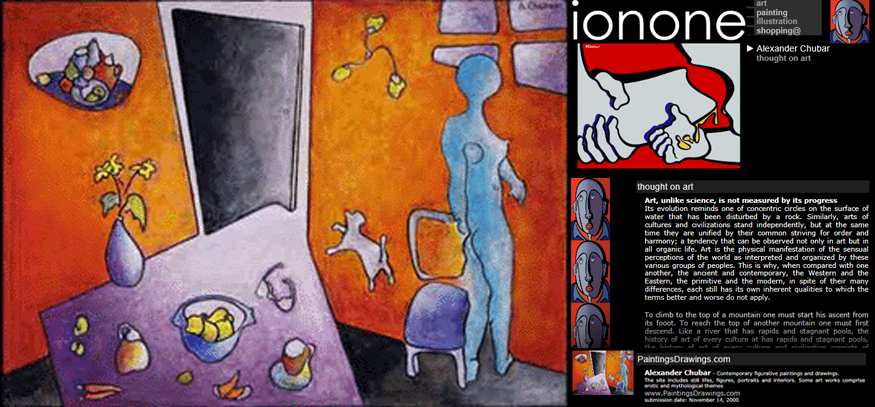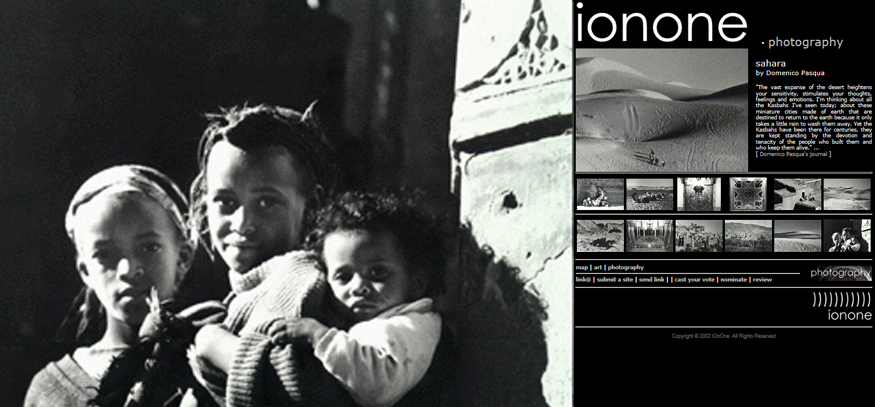art | architecture | design | digital | gallery | illustration | music | painting | photography | sculpture | video

Art, unlike science, is not measured by its progress.
Its evolution reminds one of concentric circles on the surface of water that has been disturbed by a rock. Similarly, arts of cultures and civilizations stand independently, but at the same time they are unified by their common striving for order and harmony; a tendency that can be observed not only in art but in all organic life. Art is the physical manifestation of the sensual perceptions of the world as interpreted and organized by these various groups of peoples. This is why, when compared with one another, the ancient and contemporary, the Western and the Eastern, the primitive and the modern, in spite of their many differences, each still has its own inherent qualities to which the terms better and worse do not apply.
To climb to the top of a mountain one must start his ascent from its fooot. To reach the top of another mountain one must first descend. Like a river that has rapids and stagnant pools, the history of art of every culture at has rapids and stagnant pools, the history of art of every culture and civilization consists of periods of renaissance alternated with periods of decline. For instance the first half of the twentieth century was marked by an unprecedented upsurge in the evolution of art. Then followed a period of absorption and transformation of the previous achievements on the one hand, and their total neglect and denial on the other. it is sad, but this latter current dominates in the art world today. The goal of making money prevails over the goal of making art. The importance of an art object is reduced to a minimum with the emphasis given to the spectator's perception.
Therefore an art object plays the role of a stimulus which takes its final form in the specta There is also a tendency in contemporary art toward the merging of various heterogeneous elements of styles of the past with no attempt at correlation between these elements or submiithese elements or submiandards of art to the level of comprehension of the man on the street. "Painting is a thing of intelligence" Picasso once said, meaning that its understanding requires some knowledge and ability to understand. The only art is that which serves itself; the ssion of them to the wholeness of the composition. Such a work becomes a tangle of contradictions, where disorder serves no purpose except to shock the viewer. Thus many so called artists paint eclectic works in which they are guided not by any degree of purposefulness, but rather merely by chance. Synthesis, not eclecticism, should be the goal of a thinking artist whose every detail should exist and function in harmonious union with the whole. There is also the tendency toward lowering the sttttrest is only a surrogate. A work of art contains its own intrinsic qualities which possess certain meaning and purpose.
Art functons as a mirror where the conscience of each generation is reflected in a concrete form. At present, we look at some of the reions as a mirror where the conscience of each generation is reflected in a concrete form. At the present we look at some of the refll ections with fear and repulsion, like Pasiphae at her hideous fruit of love. However, in opposition to the artistically weak and morbid creations, the principles of the other current are based on the inner structure of an art work and the cohesion of its elements that function as a whole. In this case, a work of art carries a perceptually self evident expression which a spectator does not convert into expressive and harmonious images in his mind, thus completing it; but is instead an independent entity.
The goal of evolution is improvement. Only the finest can survive this battle; an eternal battle which takes place among the representatives of each generation. The rest settle, after a time, to the bottom like det and sink into oblivion. Like all living thientatives of each generation. The rest settle, after a time, to the bottom like detritus, and sink into oblivion. Like all living thing s, an artist has a purpose. One of the meanings of his life consists of the development of his talent like a seed's purpose is to become a flower. To find his purpose in life an artist must uncover his potential. To make his life meaningful, he must fulfill that potential. The objective of a true artist is the development of a specific artistic system. He is similar to a criminal, who does not obey the old rules, but breaks them, creating hh hl, who does not -obey the old rules, but breaks them, creating his own and revealing his ego. A creator is duty bound to rethink everything with honesty, talent and ambition, creating images which correspond to his conception of reality.
When an artist paints, he does not imitate reality, but creates a new one, based on its own laws and its own principles. Also, the aim of art is not to represent the inward significance of things, but to represent the inward significance of the artist through the inward significance of the objects he paints. In the course of his work an artist relies on his intuition, knowledge and skill. With the aid of these he expresses his own conception of the ultimate reality, bringing it to perceptual level. Philosophy is the foundation on which the building of art is erected. Thus a work of art is a representation of a philosophy in a concrete form.
As snow is the crystallization of water, an art work is the crystallization of the artist's feeling; a feeling that is captured in a cage of colors and lines, in the case of painting, or by other means in other art mediums. The radiance that emanates from a work of art takes as its source that caged feeling. Like the rays of light or waves of sound which we perceive with the help of our eyes and ears, we sense this radiance through our minds and souls. It vibrates, moving and touching our senses, giving us intellectual pleasure. A true work of art is a creation of a mind for a mind. It is a harmony of symbols, which is itself a symbol.
After its completion, an art work becomes free of itits creator. It does not depend on the spectator's perception. It lives its own independent life according to its own laws, laws upon which its unity is built. In short, a work of art is an entity by itself that relies on its own qualities.
Alexander Chubar
www.PaintingsDrawings.com

"The sparkle of small stones, the long shadows cast by the mighty red earth hills, the deep furrows created by the rivers in full flood after the spring rains and the long rows of palms in the dried-up beds of these same rivers are precious images that I'll take back to Europe with me."...
"At times something fragile can last for eternity, withstanding the passing of time, overcome timidity and adversity."...
"The desert enriches you, its emptiness fills your mind and spirit, the blinding light clarifies everything, even your thoughts."...
"The vast expanse of the desert heightens your sensitivity, stimulates your thoughts, feelings and emotions. I'm thinking about all the Kasbahs I've seen today; about these miniature cities made of earth that are destined to return to the earth because it only takes a little rain to wash them away. Yet the Kasbahs have been there for centuries, they are kept standing by the devotion and tenacity of the people who built them and who keep them alive. " ...
"I can still see all those children who ran after me smiling, unaware of anything else that exists in the world today except those houses built of earth. They told me about their families, the movie sets where they were able to get work as extras, the age-old customs of the Berber society, the geometric symbols that decorate the high walls of the kasbahs; they showed me their schools and corrected my French pronunciation; they told me about their plans for the future."...
December 1999
read more »